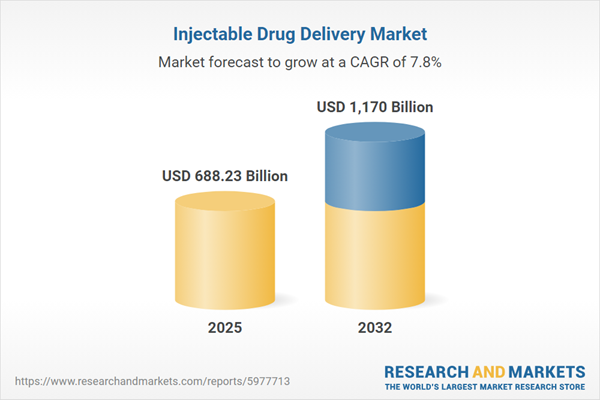Speak directly to the analyst to clarify any post sales queries you may have.
The injectable drug delivery market is rapidly evolving, propelled by advances in device technologies and shifting demand for patient-centric solutions. Senior decision-makers face new challenges and prospects as manufacturers innovate across device usability, application, and connectivity, fundamentally redefining competitive and operational strategies.
Market Snapshot: Injectable Drug Delivery Market Size and Growth
The Injectable Drug Delivery Market grew from USD 640.93 billion in 2024 to USD 688.23 billion in 2025. It is expected to continue growing at a CAGR of 7.84%, reaching USD 1.17 trillion by 2032. Robust expansion is underpinned by heightened demand for convenience, improved safety, and technological advances in therapeutic administration devices, creating significant opportunities across established and emerging regions.
Scope & Segmentation of Injectable Drug Delivery Solutions
This report assesses a comprehensive landscape, analyzing device innovations, clinical use-cases, distribution models, and strategic shifts driven by regulatory, economic, and technological factors.
- Device Types: Conventional injection devices; Self-injection devices including autoinjectors, needle-free injectors, pen injectors, and wearable injectors
- Usability: Disposable and reusable systems for single-use and sustainable, long-term operations
- Route of Administration: Intradermal, intramuscular, intravenous, and subcutaneous delivery systems tailored to varied clinical protocols
- Distribution Channels: Offline networks such as hospital pharmacies and retail pharmacies; Online pharmacy solutions for expanded accessibility
- Therapeutic Applications: Targeted treatments across autoimmune diseases, oncology, chronic conditions, hormonal therapies, and infectious disease management
- End-users: Home care settings; Hospitals and clinics; Pharmaceutical and biotech companies; Research laboratories
- Regional Coverage: Americas (United States, Canada, Mexico, Brazil, Argentina, Chile, Colombia, Peru); Europe, Middle East & Africa (United Kingdom, Germany, France, Russia, Italy, Spain, Netherlands, Sweden, Poland, Switzerland, United Arab Emirates, Saudi Arabia, Qatar, Turkey, Israel, South Africa, Nigeria, Egypt, Kenya); Asia-Pacific (China, India, Japan, Australia, South Korea, Indonesia, Thailand, Malaysia, Singapore, Taiwan)
- Company Coverage: Global and regional leaders including AbbVie Inc., Amgen Inc., Becton, Dickinson and Company, Cipla Limited, Eli Lilly and Company, Johnson & Johnson Services, Inc., Sanofi S.A., Pfizer, Inc., among others
Key Takeaways for Senior Decision-Makers
- Market participants accelerate device innovation with connected, patient-centric solutions such as Bluetooth-enabled autoinjectors and wearable injectors for enhanced adherence and convenience.
- Shifting regulatory frameworks and supply chain complexity are prompting leading firms to invest in digital platforms, nearshoring, and diversified sourcing to mitigate operational risks.
- Chronic disease management, especially in home care and outpatient settings, is driving adoption of needle-free and wearable injectable platforms, empowering end-user engagement and reducing healthcare burdens.
- Geographical differences in healthcare infrastructure, reimbursement models, and regulatory standards shape adoption patterns, from established North American markets to emerging Asia-Pacific manufacturing hubs.
- Cross-sector partnerships between pharma companies, device firms, and digital health providers support rapid market entry, joint development, and integrated therapeutic solutions.
Tariff Impact: Navigating U.S. Regulatory Changes in 2025
Recent U.S. tariff adjustments on components such as precision plastics and microelectronic sensors have increased input costs along the injectable drug delivery supply chain. Vertically integrated manufacturers benefit from internal production, while others negotiate cost-sharing across supplier networks or adjust material strategies. These pressures emphasize the necessity for agile procurement, regionalization of manufacturing, and continual reassessment of sourcing in order to stabilize budgets and maintain performance standards.
Primary Keyword Focus: Injectable Drug Delivery Market
Methodology & Data Sources
This research integrates secondary data from peer-reviewed publications, patents, regulatory filings, and industry papers, enhanced by interviews with clinicians, procurement specialists, patient advocates, and other key stakeholders. Quantitative surveys and proprietary databases provide further validation and support actionable insights tailored for market analysis.
Why This Report Matters
- Delivers strategic, segment-level intelligence to guide R&D, product positioning, and market expansion in a complex regulatory environment.
- Equips leaders with actionable understanding of shifting supply chain dynamics, technological trends, and regional adoption drivers.
- Supports investment and partnership decisions by profiling leading innovators and emergent competitors across the value chain.
Conclusion
Senior executives in pharmaceutical, biotech, and device sectors will benefit from this report’s comprehensive, data-driven insight into market trends, product innovations, and operational challenges. Informed strategies will be essential to unlocking growth and resilience in the evolving injectable drug delivery domain.
Additional Product Information:
- Purchase of this report includes 1 year online access with quarterly updates.
- This report can be updated on request. Please contact our Customer Experience team using the Ask a Question widget on our website.
Table of Contents
3. Executive Summary
4. Market Overview
7. Cumulative Impact of Artificial Intelligence 2025
Companies Mentioned
The companies profiled in this Injectable Drug Delivery market report include:- AbbVie Inc.
- Amgen Inc.
- Antares Pharma by Halozyme Therapeutics
- Becton, Dickinson and Company
- Cipla Limited
- Dr. Reddy’s Laboratories Ltd.
- Eli Lilly and Company
- Emperra GmbH
- Enable Injections LLC
- F. Hoffman - La Roche Ltd.
- GlaxoSmithKline plc
- Insulet Corporation
- Johnson & Johnson Services, Inc.
- Medtronic PLC
- Novo Nordisk A/S
- Pfizer, Inc.
- Ravimed Sp. z o.o.
- Recipharm AB
- Sanofi S.A.
- Stevanato Group
- Sun Pharmaceutical Industries Ltd.
- Tandem Diabetes Care
- Teva Pharmaceutical Industries Ltd.
- West Pharmaceutical Services, Inc.
- Wilhelm Haselmeier GmbH & Co. KG
Table Information
| Report Attribute | Details |
|---|---|
| No. of Pages | 180 |
| Published | November 2025 |
| Forecast Period | 2025 - 2032 |
| Estimated Market Value ( USD | $ 688.23 Billion |
| Forecasted Market Value ( USD | $ 1170 Billion |
| Compound Annual Growth Rate | 7.8% |
| Regions Covered | Global |
| No. of Companies Mentioned | 26 |









